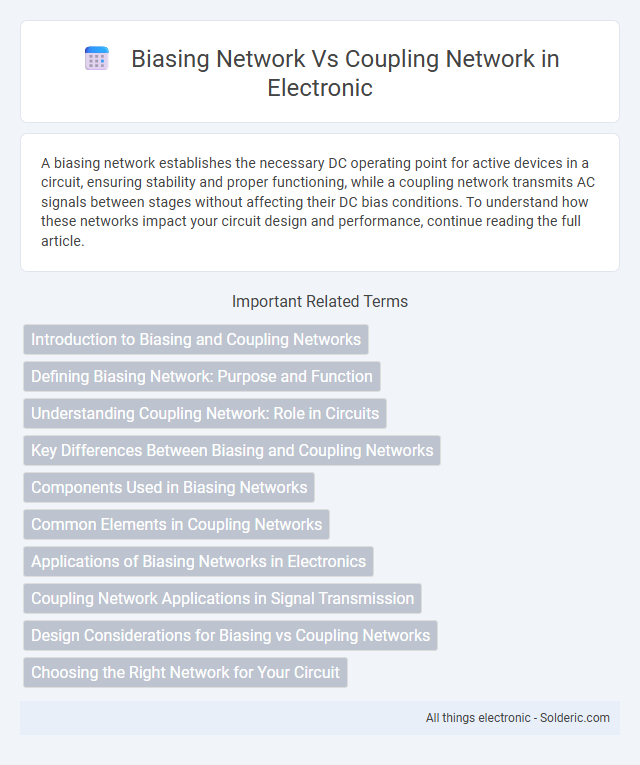A biasing network establishes the necessary DC operating point for active devices in a circuit, ensuring stability and proper functioning, while a coupling network transmits AC signals between stages without affecting their DC bias conditions. To understand how these networks impact your circuit design and performance, continue reading the full article.
Comparison Table
| Aspect | Biasing Network | Coupling Network |
|---|---|---|
| Primary Function | Provides DC bias to active devices for proper operation | Transfers RF signals between stages while isolating DC components |
| Components | Resistors, inductors (RF chokes), capacitors | Capacitors, transformers, transmission lines |
| Frequency Range | Wideband for DC and low frequencies | Designed specifically for RF and high-frequency signals |
| Signal Type | DC current and voltage supply | AC signals, primarily RF |
| Isolation | Blocks RF from power supply, passes DC to device | Passes RF while blocking DC between circuit stages |
| Role in Circuit | Maintains device linearity and stability | Ensures efficient signal transmission and impedance matching |
Introduction to Biasing and Coupling Networks
Biasing networks establish the operating point of active devices like transistors by providing a stable DC voltage or current, ensuring consistent performance regardless of signal variations. Coupling networks transfer AC signals between different circuit stages while blocking DC components, preserving correct biasing conditions and signal integrity. Understanding the distinction between biasing and coupling networks is crucial for designing reliable amplifier and signal processing circuits.
Defining Biasing Network: Purpose and Function
A biasing network establishes the proper operating point of active devices, such as transistors, by providing stable DC voltage or current. Its primary function is to ensure consistent device performance regardless of variations in temperature or transistor parameters. Unlike coupling networks that transfer AC signals between stages, biasing networks maintain the necessary quiescent conditions for linear amplification.
Understanding Coupling Network: Role in Circuits
Coupling networks serve a critical role in circuits by enabling the transfer of signals between different stages while isolating DC components, thus preserving desired operating points of active devices. Unlike biasing networks, which establish the correct DC voltage and current levels for transistor operation, coupling networks primarily handle the AC signal path and block DC offsets to avoid interference. Effective coupling networks use capacitors or transformers to maintain signal integrity and prevent unwanted DC feedback that could disrupt circuit performance.
Key Differences Between Biasing and Coupling Networks
Biasing networks establish a stable operating point for transistors by providing DC voltage and current, ensuring consistent device performance under varying conditions. Coupling networks, on the other hand, facilitate the transfer of AC signals between stages while blocking DC components to prevent disturbance in bias points. The critical distinction lies in biasing networks managing DC operating conditions and coupling networks enabling AC signal transmission without affecting DC biasing.
Components Used in Biasing Networks
Biasing networks primarily use resistors, diodes, and sometimes capacitors to establish stable operating points in electronic circuits, ensuring consistent transistor performance. These components help maintain desired current and voltage levels despite variations in temperature or transistor parameters. In contrast, coupling networks mainly consist of capacitors and inductors, facilitating signal transfer between stages while blocking DC components.
Common Elements in Coupling Networks
Common elements in coupling networks include inductors and capacitors, which facilitate signal transfer while isolating different circuit stages. These reactive components minimize signal loss and prevent unwanted interference, ensuring stable performance in RF and communication circuits. Your design benefits from carefully selecting these elements to optimize frequency response and impedance matching.
Applications of Biasing Networks in Electronics
Biasing networks are essential in electronic circuits for establishing a stable operating point in transistors, ensuring consistent amplification and switching performance. They are widely used in amplifier design, RF circuits, and analog signal processing to stabilize the transistor's operating region and prevent distortion. Unlike coupling networks that manage AC signal transfer between stages, biasing networks specifically provide the necessary DC voltage and current conditions for reliable device operation.
Coupling Network Applications in Signal Transmission
Coupling networks play a crucial role in signal transmission by enabling efficient energy transfer between circuits while maintaining impedance matching and minimizing signal loss. They are commonly used in RF systems, antennas, and communication devices to isolate DC biasing elements from AC signal paths, ensuring signal integrity. Unlike biasing networks that supply voltage or current to active components, coupling networks primarily facilitate the seamless flow of signals across different circuit stages.
Design Considerations for Biasing vs Coupling Networks
Design considerations for biasing networks prioritize stable DC voltage and current levels to ensure proper transistor operation, emphasizing components like resistors and capacitors that provide steady bias points while minimizing thermal variations. Coupling networks focus on maximizing AC signal transfer between stages without affecting DC bias, often using capacitors chosen for their impedance at operating frequencies to block DC and pass AC efficiently. Your selection between these networks depends on balancing signal integrity with transistor stability, ensuring the overall circuit performs reliably under varying conditions.
Choosing the Right Network for Your Circuit
Selecting the appropriate network for your circuit depends on the specific function required: biasing networks stabilize transistor operating points by providing consistent DC voltages, while coupling networks transmit AC signals between stages without affecting DC biasing. Biasing networks typically use resistors and sometimes diodes to set defined voltage levels, whereas coupling networks employ capacitors or transformers to block DC components while allowing signal passage. Understanding these distinctions ensures optimal performance, minimizing distortion and maintaining signal integrity in analog and RF circuits.
biasing network vs coupling network Infographic

 solderic.com
solderic.com